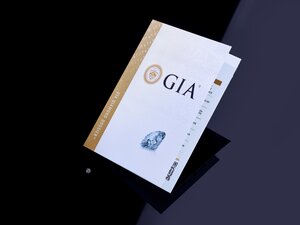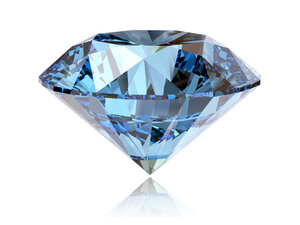CREATED DIAMOND
Synthetic diamonds are stones grown in a laboratory, optical chemical and physical properties are difficult to distinguish from natural diamonds. The 4 C's are determined like those of naturally grown diamond. So, contrary to diamond imitations such as zirconia or synthetic moissanite in inexpensive jewellery, lab-grown diamonds are also 100% carbon and have the same hardness. However, the much softer zirconia stones are artificially produced ice crystals made of zirconium oxide.
Contrary to the diamond imitations such as zirconia or synthetic moissanite in cheap jewellery, the diamonds produced in the laboratory are also 100% carbon and have the same hardness. However, the much softer zirconia stones are artificially produced ice crystals made of zirconium oxide.
The round or brilliant cut is considered the classic and also most popular diamond shape.
We offer diamonds in all sizes and qualities, also precisely calibrated according to diameter or weight.
The diameters vary on average with 0.05 - 0.1 mm.
We have specialised in the colours D-G (Top Wesselton) and the purity VS and SI.
Our delivery time is usually 1-2 working days.
Oval cut
- The symmetrical, elongated rounded shape is a popular alternative to the classic round cut
- Oval diamonds look larger compared to roughly round diamonds of the same carat weight. In addition, this shape is particularly advantageous for short fingers.
Teardrop cut
- The "pear cut" resembles a glittering drop. Diamonds in the teardrop cut have always been a popular choice for engagement rings. Unlike the round or oval cut, they are asymmetrical and therefore a little more special.
- The hue of the diamond is very visible, especially at the pointed end. Therefore, when choosing one, look for a shade at the upper end of the scale.
Radiant cut
- An angular diamond shape that achieves high brilliance through numerous facets
- Unlike the princess cut, it belongs to the step cuts and therefore shines with fewer facets in comparison
- Radiant-cut diamonds are not only available in a square shape, but also in an elongated rectangular shape
Princess cut
- This is an angular diamond shape that differs from the radiant cut in the arrangement of the facets
- Its square shape with the typical 57 or 76 facets gives diamonds in this shape a breathtaking sparkle. A great side effect: the many facets of this cut conceal small impurities inside the diamond.
Emerald cut
- Called an "emerald cut" in English. This is one of the most elegant cuts and belongs to the group of step cuts. In contrast to the brilliant cut, it has fewer but larger facets.
- Because of its relatively large table (the top, largest facet), it is recommended to look for particularly high clarity (e.g. VVS, VS1) when choosing a diamond in this cut
- Emerald cut diamonds look enormously noble & elegant and are absolutely timeless
Baguette cut
- Baguette cut diamonds are about two to three times as long as they are wide
- Viewed from above, their shape typically corresponds to an exact rectangle
- The few, large facets of the baguette cut make these diamonds sparkle less than round diamonds, for example
- However, hardly any other shape appears as luxurious and noble as this cut
Why do I need a certificate when buying a diamond?
- The task and aim of the laboratories is to give buyers of a certified diamond the certainty that the diamond is actually of the quality for which you have paid
- The diamond is examined by a team of gemologists or diamond appraisers according to criteria that are defined worldwide
What do I have to consider when buying a certified diamond?
- A certificate is an independent, neutral and professional evaluation of a diamond, which proves the quality and thus also the value of the diamond and thus also objectively ensures the value in case of resale
- For this reason, we only offer diamonds with certificates from certification institutes that enjoy the highest recognition
These are:
Gemological Institute of America (GIA)
- GIA was founded in 1931 and is today the best known and most respected institute in the world
- This institute produces precise appraisals and interprets the valuation criteria most strictly
- Diamonds with a GIA certificate therefore have the greatest stability of value. For this reason, when buying, it should be noted that diamonds that have been awarded with this organisation usually fetch the highest prices.
Hooge Raad voor Diamant (HRD)
- Diamonds with certificates from HRD, are widely used, especially in Europe
- The certificates of HRD, a certification institute based in Antwerp, are highly recognised because they are accurate and strict in the evaluation of diamonds
- The institute is more or less the European equivalent of GIA
- Compared to GIA, HRD tends to rate slightly more strictly in the upper range of the colour scale and slightly less strictly in the lower range. HRD diamonds are therefore somewhat cheaper.
International Institute of Gemology (IGI)
- The institute with its headquarters in Anwerpen is one of the oldest and largest certification bodies worldwide
- IGI certificates can be assumed to value diamonds higher than GIA or HRD - this means that in borderline cases, they tend to choose the better valuation
- This is the reason why IGI stones are sometimes cheaper
How do I know if the diamond and the certificate belong together?
The diamonds have a laser inscription in the diamond's roundel. This is only visible under 20x magnification with a trained eye. However, the inscription clearly assigns the respective certificate to the diamond.
Among the white diamonds, the colours D - G are most in demand. When the colour concentration is low due to the influence of nature, diamonds have less value. Only as soon as there is a high percentage of colour in the diamond again, they are popular again and there is an increase in value. This is the case with the colour scale for diamonds when the colour is thinner than the Z colour.
The so-called fancy diamonds, where the colours in the diamond are all of natural origin, are traded in unbelievably high prices. Especially the pink diamonds fetch the highest prices. This is because pink and blue diamonds are very rare. Even of the ruby diamonds, only over 10 carats are known in the world.In our colour treated diamonds, the colour is integrated into the diamond through an identical imitation of the natural conditions. The technique used for this is called HPHT (High Pressure, High Temperature). Incidentally, this is the same technique that is used for the production of artificial diamonds.
The coloured diamonds that occur in nature are created by adding the following to the pure carbon:
- Yellow and brown diamonds: With these colours, a high proportion of nitrogen is also present in the diamond.
- Blue diamonds: Blue diamonds also have a high proportion of boron in the diamond.
- Black diamonds: Black diamonds also contain a high proportion of graphite.
- Pink diamonds: The colour is created by a plastic deformation of the carbon atoms.
A revolution?
In fact, synthetic diamonds can be produced in the laboratory since 1956.
Especially for industry, they are indispensable, because natural diamonds cover less than 2% of the demand for industrial use. In the meantime, CREATED DIAMOND is also available in excellent jewellery quality.
This development is welcomed by most people from many aspects, as natural diamonds are becoming rarer, old deposits are running out and hardly any new mines are being developed.
Since natural diamonds are often mined under poor working conditions and unbelievable energy expenditure, more and more jewellery manufacturers, such as the multinational Pandora, are advertising that they will do without natural diamonds from now on. In May 2021, it was announced that only synthetic diamonds would be processed. They are even somewhat cheaper, but have the same characteristics as natural diamonds. Diamonds are not only for eternity, but also for everyone, explained company boss Alexander Lacik. Stars like Leonardo Di Caprio advertise these ethically pure and resource-saving stones.
So there is a spirit of optimism in the industry. Although the use of CREATED DIAMOND in jewellery production is currently still low when compared to the overall market, if one looks at the forecasts, there is a chance that the artificially produced diamond will overtake the natural gemstone in a few years.
Manufacturing process
Synthetic diamonds are manufactured using two different methods - CVD and HPHT.
CVD diamond
- stands for "chemical vapour deposition" - which actually refers to a coating process
- In a chemical reaction, the solid (in this case diamond) is deposited from a hot gas (plasma, with carbon from methane gas)
- No high pressure is used in the process
- A small nuclear diamond is used as a nucleus, on which the atomic layers build up on each other or are deposited
- Conflict-free: The diamonds are not extracted from a conflict region. Therefore, the stones are 100% conflict-free and definitely not potential so-called blood diamonds for financing wars.
- Resource-saving: To mine 1 ct of mine diamond, about 200 -250 tons of earth are moved. That is about 65-70m³ for 1carat and a ratio of 0.2 grams to 200,000,000 grams or 1 to 1 billion. The energy input is immense. Therefore, the production of synthetic diamonds is extremely more environmentally friendly in comparison.
- CREATED Diamonds usually also have inclusions like the natural diamonds, which also makes these stones very special
- The difference to a natural diamond is absolutely not visible to the naked eye or 10-fold magnification with the same quality
- The price for CREATED Diamond is 50-70% of the natural diamond and so your customer can get a larger stone set for the same budget
- Of course, natural diamonds still have their right to exist
- Natural diamonds are formed under high pressure over several million years under the earth. They are unique and in limited supply. This is not the case with laboratory diamonds.
- The stone is artificial and thus does not have the uniqueness and "time spent in the depths" of the earth. However, this is exactly what some people may be looking for in an engagement ring.
- Compared to naturally grown diamonds and the rarity, synthetically produced diamonds have no real resale value
- The availability of high purity stones - flawless diamonds (IF) is very limited
Distinguishing between synthetic and natural diamonds
Gemological institutes also issue certificates for synthetic stones, which are marked with a laser engraving on the rondiste just like natural diamonds. The recognition of cut synthetic diamonds is not possible without examination in the laboratory.
By measuring the absorption spectrum in the infrared range, for example, the absence of nitrogen can be detected. Only 2% of the diamonds grown in nature do not have nitrogen.
In addition, devices such as the Diamond View can be used to check the distribution of UV fluorescence characteristic of HPHT syntheses.



